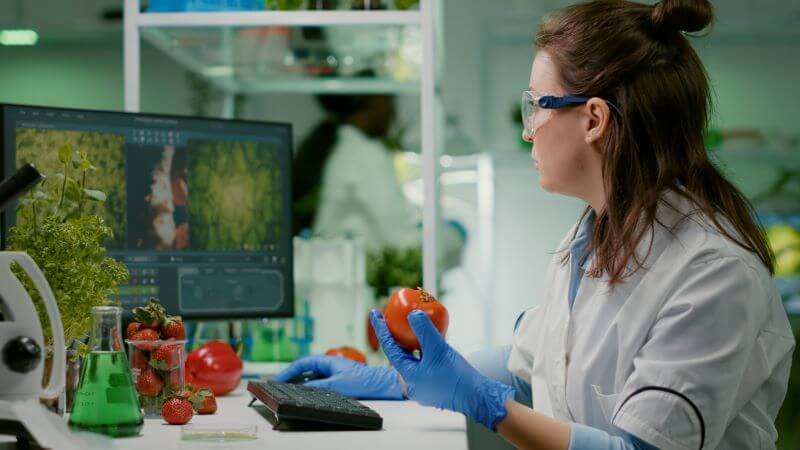What if your future meals included cricket chips, algae-infused pasta, and lab-grown meat? Once considered science fiction, this scenario is slowly becoming a reality. Amid ecological innovations and technological breakthroughs, the superfoods of tomorrow promise a more sustainable and nutritious way of eating. Dining in the future!
In an ever-evolving world, our food choices are adapting alongside it. Superfoods, foods with exceptional nutritional properties, are on the verge of transforming our diets.
But what does the future hold for us? Crunchy insects, microscopic algae, and lab-designed foods might soon take center stage at our tables. Let’s explore this futuristic feast and examine the innovations that could reshape our eating habits.
Insects: From Disgust to Delight
An Eco-Friendly Protein Source
Insects are emerging as a sustainable alternative to traditional animal proteins. Their farming requires less land, water, and produces fewer greenhouse gas emissions compared to livestock farming. This ecological efficiency makes them an appealing option for feeding the growing global population.
For instance, producing one kilogram of cricket protein requires just 2 liters of water, whereas beef production demands 15,000 liters. Additionally, insects can be farmed vertically, significantly reducing the land footprint needed for their cultivation.
An Impressive Nutritional Profile
Edible insects are nutritional powerhouses. Their protein content is remarkable; some species, such as crickets, offer up to 70% high-quality protein, rich in essential amino acids. They are also an excellent source of iron, zinc, and B vitamins—key nutrients needed for energy and immunity.
Another significant advantage is their omega-3 and omega-6 fatty acid content, comparable to that of fish, positioning them as a heart-healthy choice. Moreover, their high fiber content, particularly in the form of chitin, may support healthy digestion and a balanced gut microbiome. All these factors make insects a superfood of the future!
From Exotic Cuisine to Everyday Meals?
With two billion people already consuming insects globally, they are integral to many traditional cuisines. The challenge lies in integrating them into Western diets by showcasing them in appealing and familiar forms.
Innovative startups are developing insect-based products that mimic commonplace foods. Examples include cricket protein bars, pasta enriched with mealworm powder, and crispy chips made from grasshoppers. These products aim to make insect consumption more approachable and less intimidating for Western consumers.
Microalgae: The Ocean’s Superheroes
Spirulina, The Magical Ingredient of Tomorrow
Spirulina, a blue-green microalga, is establishing itself as the ultimate superfood. With over 60% complete protein, it is an incredible source of essential nutrients. Its exceptional nutritional profile makes it a powerful ally for health and well-being.
Spirulina contains all essential amino acids, making it a rare complete protein in the plant world. It’s also high in iron, beta-carotene, and essential fatty acids. Some studies even suggest that spirulina may possess anti-inflammatory and antioxidant properties.
An Ecological Revolution
Growing spirulina requires 100 times less water than meat production. This efficiency, combined with its nutritional richness, presents a promising solution for sustainable and nourishing diets.
In France, the company Etika Spirulina, an urban organic spirulina farm located in the Lille metropolis, produces between 1,500 and 2,000 kg of certified organic spirulina each year.
Endless Possibilities
Microalgae can appear on our plates in various forms: powders, dietary supplements, and even integrated into everyday products. Their neutral flavor allows for diverse applications, paving the way for numerous culinary innovations.
Here are examples of products containing microalgae:
- Chips, biscuits, and crackers with seaweed.
- Waffles, muffins, and cookies infused with spirulina and microalgae.
- Pasta enriched with algae to boost protein and mineral content.
- Fermented drinks featuring algae, such as algae-enriched kombucha for probiotic benefits.
Lab-Grown Foods: Science Serving Nutrition
Meat Without the Animals: The Rise of Cultured Meat
Lab-grown meat signifies a major breakthrough. Cultivated from animal cells without farming or slaughtering, it could transform how we consume meat.
- Reduced animal suffering: no slaughtering involved.
- Less environmental impact: lower greenhouse gas emissions and water usage.
- Controlled composition: potentially less saturated fat and fewer antibiotics.
Plant-Based Milk and Eggs: A Revolution Underway
Plant-derived alternatives to dairy and eggs are multiplying, with innovations increasingly resembling the taste and texture of their animal-based counterparts.
- Milk derived from almonds, oats, peas, and more.
- Plant-based eggs made from pea or soy proteins, perfect for baking.
- Dairy-free cheeses fermented with bacteria to replicate traditional cheese flavor.
The Risks of Superfoods
While these new superfoods hold great promise, caution is essential. Their processing can sometimes diminish their benefits. For example, improperly cultivated microalgae may contain toxins. Additionally, trends can sometimes lead to excess: excessive spirulina consumption might disturb iron or iodine balance. As for insects, their potential allergenicity is still not well understood.
With nutrient-rich microalgae, ultra-protein-packed insects, and plant-based alternatives, the superfoods of tomorrow promise a revolution on our plates. However, their acceptance will require a shift in mindset and careful consideration of their long-term effects. So, are you ready to bite into a seaweed burger or an energy bar made from crickets? The future of food is already underway…
NOTE
On January 20, the European Commission authorized the market introduction of Tenebrio molitor larvae powder (mealworm) in food products such as bread and compote, starting from February 10.







